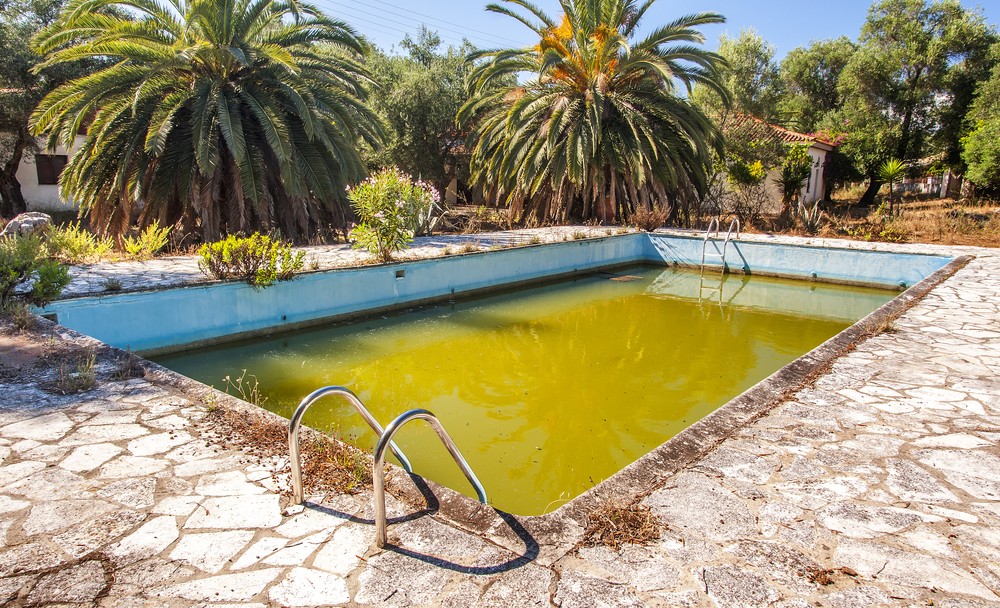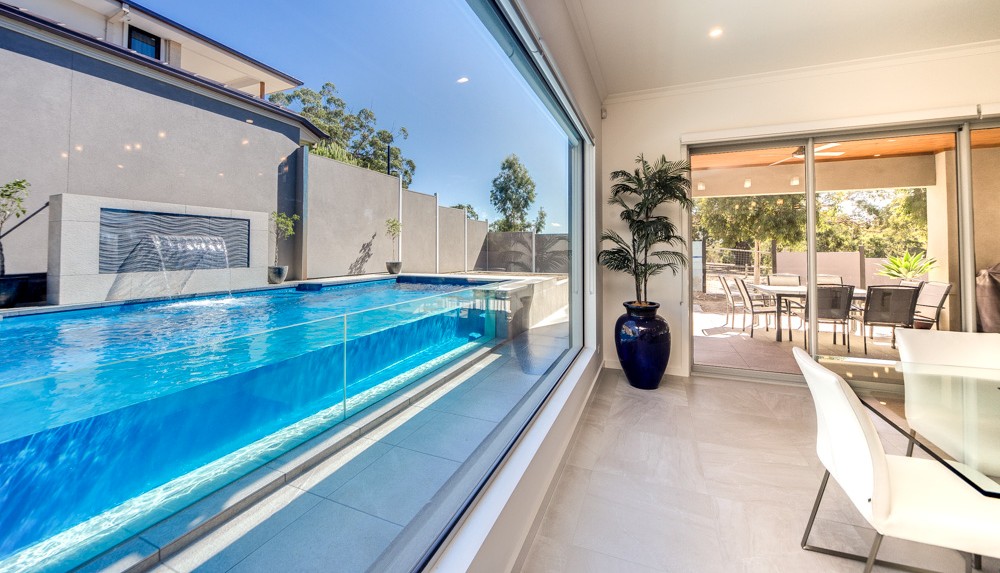If you have an issue with constant algae in the pool, you should know that your typical sanitiser and chemicals won’t get rid of it. The sun enables pool algae bloom to spread across your pool, and it’s easy to overlook when you first notice a small growth around your stairs or on the pool’s edges. But, pool algae can quickly turn into a massive problem if you don’t remove it and take steps to prevent it from growing in the first place.
Defining Algae in the Pool
Almost any soil or plant debris contains cyanobacteria algae. The spores are light enough for the breeze to carry them right into your pool water, or they can catch on your swimwear and you can add them to the water yourself. You’ll always have algae in your pool, but a few things can kick off an algae bloom. You could have inadequate filtration for your pool’s size or low or inconsistent chlorine levels.
Bad water circulation with dead spots or pool imbalance in your pool chemicals are also two big culprits. One or any of these factors can kick off a pool algae bloom that spreads across your pool. If it’s warm and sunny out, you can have a full-blown infestation in a few hours. Algaecide is an effective way to help you with filtration, sanitation, and water circulation and get rid of black, green, or yellow algae growth.
The Four Most Common Types of Pool Algae
Although there are over 20,000 types of algae in existence, and you can break them down by colour. There are four broad categories that you can use to identify the algae in your pool.
Category One – Black Algae
Black algae is extraordinarily difficult to remove from your pool once it takes hold. It has a durable protective layer that makes it difficult to scrub, with strong roots anchoring it to your pool walls. The roots will grow into your tile or grout, and you have to remove all of the root to treat it.
In terms of appearance, black algae has a very dark green colouring with black spots.
Category Two – Green Algae
Any pool owner in Melbourne or anywhere in Victoria should be very familiar with green algae because it’s the most common strain. Filtration problems or hazy water can bring it out, and it likes to cling to the walls or float in the water. A green algae bloom will give you a green pool. You can see it as pool algae sheets or small spots floating in your water, and it can form a green slime.
Category Three – Pink Algae
Pink algae is actually bacteria that comes in streak or spot form and appears in your pool’s corners and crevices. It grows very slowly, and it most likely won’t take over your whole pool. It works best in pools with bad filtration, and it’ll attach to any smooth surface like the walls or pool toys. To treat it, you have to increase the chlorine levels in your pool and apply shock.
Category Four – Yellow Algae
Mustard algae likes to stick to your pool walls in shaded areas. It’s difficult to get rid of once it takes hold, and it forms in sheets. You could spend weeks trying to get rid of it because it’s so easy to re-contaminate your pool. Small pockets can cling to pool toys, cleaning equipment, or inside the pool filter, and it is resistant to chlorine.

Pool Algae Causes
Once algae gets into your pool water, they can turn into an algae bloom if you have nitrates, out-of-balance chemicals, warm temperatures, sunlight, carbon dioxide, or phosphates. Poor water circulation, poor filtration, and not sanitising your pool will also contribute to rapid growth. When it gets sunny and warm out, the algae spores take any carbon dioxide present and push out the oxygen to create the perfect growing environment. It needs food to grow, and there is plenty in your pool water due to contaminants and dust. They can feed off dead pool algae too.
Pool Algae Prevention
Controlling your chlorine levels is the best way you can prevent a pool algae growth explosion. Maintain good water balance, run your filtration system every day, and add an algaecide into the water once every week. Your alkalinity rating should be 100 ppm, your pH should be 7.2, and the cyanuric acid level should fall between 30 and 50. These are the best levels to stop algae before it takes hold.
You want your water to go through two complete turnovers every day. Your chlorine should fall between 2 and 4 ppm, and your water should circulate constantly. Mineral or ozone supplements and UV treatment can work well too. If it’s possible, add the following to your water:
- Minerals – Copper, silver, and gold are all minerals that slow down algae growth. You’ll get chelated forms of these minerals that will stop them from staining your pool walls, equipment, and flooring.
- Chitin – Chitin can stop algae growth by cleaning a large range of contaminants that the algae feeds on out of the water. This also boosts the effectiveness of your filtration system and pool sanitiser.
- Phosphate Remover – Phosphate makes up the main portion of the algae’s diet. Fertiliser runoff or leaf debris falling into the pool can increase phosphate levels, and this chemical removes it.
- Potassium Tetraborate – This chemical stops algae from turning carbon dioxide into a food source that it uses to bloom and spread.
How to Remove Algae From Your Pool Water
Removing algae from your pool involves several components. First, double-check that your pool’s sanitation, filtration, and circulation systems are all working. Check your pool’s chemistry too. Make sure to vacuum your pool at least once a week to remove debris if you don’t have a self-cleaning pool. For an isolated algae bloom, use granular chlorine to treat it. You can also get a brush, apply algaecide to the water, and scrub. If you have free-floating algae, you’ll have to shock your pool.
To start, balance your pool water to get your pH between 7.1 and 7.3. Check your filtration and pump systems, and shut off your heater if you have one running to lower the water temperature. Adjust the valves on your pump and let it run for 24 hours. You can stir the algae up by switching your pool cleaners on. Get a stiff bristled brush and scrub at your pool’s walls and floors every day, and vacuum your pool. For green water, apply a flocculent and shock it.
Shock the pool vigorously to get rid of suspended algae. You should add enough shock that it turns your pool water a blue/grey colour. You’re aiming for 30 ppm of free chlorine, and you’ll need roughly 2 to 5 kg of shock for every 10,000 gallons in your pool. The day after you shock your pool, test the chemical levels, paying close attention to your pH and chlorine. If your chlorine is below 5 ppm, you have to shock it again.
Before you add algaecide, the chlorine should be below 5 ppm. Once you add it, brush the sides of your pool and vacuum it up once it settles. You can add a clarifier if your filter system struggles to clear it up, and you’ll want to test and re-balance your chemicals.
For a black algae infestation, brush the algae hard enough to tear the protective layers. Doing so will help chemicals sink into the roots and kill it. As long as it’s only on the walls and not free-floating, shock the pool. Add the algaecide, let it work for two to three days, brush it again, vacuum up any debris, and backwash your filter system.

Install a Fibreglass Pool
Installing a fibreglass pool could be a viable option to help you avoid a lot of the work that comes with an algae bloom or algae growth. Fibreglass resists algae growth, and the smooth surface makes it difficult for algae to take hold. If you choose to install a fibreglass pool from Compass Pools Melbourne, be sure to ask about the Vantage Self-Cleaning System. This system continually circulates the water, and reduces the amount of chemicals you have to use.
It does need the same water balance to work well, but you’ll use fewer chemicals to achieve that balance. The Vantage System removes any dead spots in the pool where algae can thrive, and you get clean and clear water to swim in.
Contact Compass Pools Melbourne Today
Are you ready to get a gorgeous pool and avoid a costly and time-consuming algae bloom? If so, contact us at Compass Pools Melbourne. We’re happy to help you make the best choice and discuss your options.







